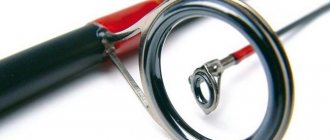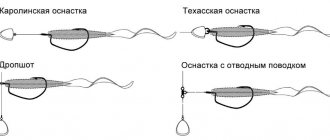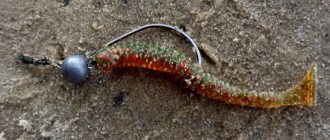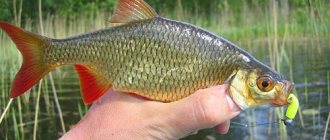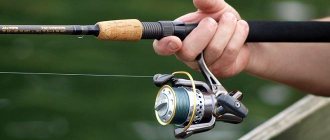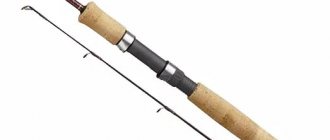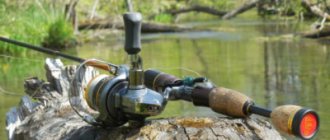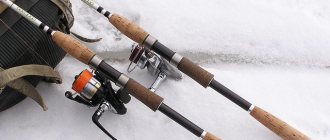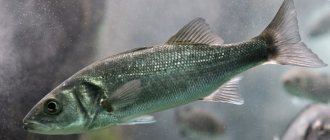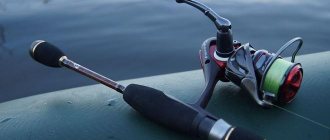Fishing Features
Many fishermen go to the resort with their families in the summer and temporarily sheathe their gear. But they don’t realize that the sea is no less the best place to enjoy their favorite hobby of fishing, even on vacation, catching various representatives of ichthyofauna that are not found in freshwater bodies of our latitudes.
For reference! In this material we do not take into account the Baltic Sea due to its low salinity. There they mainly hunt by trolling or vertically for pike perch, salmon, and less often for cod and eel.
The most popular, in terms of using spinning rods, is the Black Sea. There are many interesting underwater inhabitants here that fall for artificial baits:
- goby;
- scorpionfish;
- sea ruff;
- horse mackerel;
- rock bass;
- flounder;
- mullet;
- garfish;
- bluefish
All listed species are divided into two large categories: demersal and pelagic fish. The first one feeds in the lower layers. They are usually sedentary and migrate little across the water area. The latter feed in the middle horizons and near the surface, and move a lot in search of food.
In addition, all fish that are caught at sea can be divided into day and night inhabitants. Naturally, it’s easier to fish during daylight hours, but many promising places are occupied by fellow hobbyists or vacationers. But in the dark the results are higher, but the fishing itself is more difficult and requires some experience and appropriate equipment.
Fishing at sea from the shore with a spinning rod
Summer has begun - the holiday season. A traditional family vacation for many is still a trip to the Black Sea coast. This is a good thing, but for many spinning anglers, a multi-day outing to a fishing base on the shore of the “fishing Eldorado” is preferable. Unfortunately, not all wives accept this option, and neither do children. And there’s only one vacation... If you have this situation, don’t be upset! And on the Black Sea you can fish with a spinning rod! This fishing is very interesting, exciting and rewarding, and after your vacation you will have a lot of impressions!
The sea coast, especially with a rocky bottom, is densely populated by various representatives of ichthyofauna, including predators. In general, all sea fish can be called predatory! Of greatest interest to the spinning angler are scorpion fish, sea crucian carp (weasel), sea bass, bluefish, horse mackerel, greenfish, galley (conger eel), croaker and goby. The size of sea predators is not very large. The catches are dominated by individuals weighing up to 400 grams. But this does not mean that fishing is not interesting! So, for example, 200 grams of lassir will give you a light so that after catching your hands will shake for a long time. A spinning rod with dough up to 10 grams bends into an arc when fished!
The peculiarity of sea fishing is that you need to go to the coast at dusk and leave before sunrise! Most predators are active at night. In principle, the fish feeds all night, but there are so-called peaks of activity. The best bite is observed with the onset of complete darkness, and continues for about two more hours. Then the fish's activity weakens and resumes two to three hours before sunrise. In two hours of activity, you can earn a lot of bites, and a wide variety of fish. You never know exactly what fish you'll catch on your next cast, and that's one of the things that makes saltwater spin fishing fun.
As I already said, the most promising places for fishing are rocky shores. There are a lot of them on the Black Sea coast! It is not necessary to look for some wild places for fishing. You can fish excellently on the beaches, directly from the shore, or by choosing a pier. By the way, in resort areas, beach fishing has its advantages. The light of restaurants, clubs and hotels can completely replace natural light, and it will be more convenient for the spinner to perform various manipulations with bait and caught fish. However, even if the beach is well lit, the spinner should still have a headlamp on his head. Without him on the night coast it’s like without a leg.
What gear should you take with you on vacation? Taking into account the specifics of fishing, the best choice is light or street rods of the “rockfish” concept. They were created specifically for sea fishing with a spinning rod from the shore. This type of fishing is very popular in Japan, and the engineers of Japanese fishing companies know exactly what qualities a spinning rod should have for such fishing. Rock fishing sticks are lightweight, sensitive and have good range. The thin tips, which perform the function of a nod, are painted white. Due to the natural ability of white to reflect light well, the tip is perfectly visible on a poorly lit beach or at dusk. The reel should have a smooth ride, and the tackle should also be well balanced. An important point: all elements of the reel that have contact with the cord must be coated with a coating that is resistant to salt water. As for the cord, ideally it should be from a marine series specifically designed for rock fishing. The qualitative difference between such cords is that when in contact with stones and shells, it does not fray, which means it lasts longer. In the absence of the possibility of using such a cord, a fluorocarbon leash, 3-4 meters long, is mandatory. It will reliably protect your wallet from constant loss of baits due to cuts on stones covered with shells.
The gear described above is an ideal option that will allow you to get maximum pleasure from the fishing process. But don't fret if you don't have a lightweight rockfishing kit. Using all kinds of lead equipment, you can successfully fish with any, even the cheapest spinning rod. The fishing technique is not much different from catching the same perch in freshwater bodies.
I’ll tell you briefly about the baits. At sea you can use absolutely any type of bait up to 5 cm in size! The most effective are wobblers and jigs. Wobblers must be deep, with a long blade, which will serve as good protection for the bait from being lost in the stones. However, fishing with wobblers is successful only during periods of high fish activity. When the bite is bad, I recommend using jig baits! You can fish with regular vibrating hooks and twisters of the “old generation”, but it is better to use an edible bait. It significantly increases the number of bites, and edible baits, due to their strong smell, attract fish better. In conditions of poor bite, the most effective are retrieves with long pauses, when the bait simply lies on the bottom. This is where the properties of edible rubber come to the fore! I do not recommend equipping silicone baits with classic or articulated round jig heads, as there will be a large number of losses in the stones. It is best to use jig-rig type rigs with drop-shaped or cylindrical weights, or use lead rigs with a bullet-shaped weight.
Vacation is just around the corner, friends! I am sure that fishing with a spinning rod at sea will give you no less pleasure than the usual lake and river fishing for traditional predators of the middle zone.
No tail, no scales.
Tackle
As it turns out, spinning fishing in the sea is possible with different gear. We can recommend doing rock fishing, using a retractable leash, jig rig, drop shot. Oscillating spinners and wobblers may well shoot.
For reference! The founders of sea spinning fishing are the Japanese. It was they who developed two types of fishing: Rock Fishing - hunting for bottom fish and Ajiing - fishing for horse mackerel.
If you are not planning targeted fishing on the open sea on a boat with an eye on trophy fish, then powerful gear is of no use. A light or medium class kit is quite suitable. It will be enough for fishing at shallow depths in the coastal zone.
Rod selection
For coastal fishing in the sea, rock fishing rods are used. Their distinctive feature is a powerful thick butt and a movable, sensitive tip, which clearly conveys all the movements of the bait and is capable of recording any bite from a predator.
Sea spinning rod for rock fishing has a length of 1.8 to 3.3 meters. The longer the “stick”, the further the angler can send the bait. This must be taken into account and you must choose a tool based on fishing conditions. If you have to fish short, then there is no need for a tall rod.
All rock fishing rods can have either a hollow tip or a solid tip. The first, designated by the letter “T” - tubular, is more universal. It is suitable for various baits, from small silicone to wobblers. The second, marked with the letter “S” - solid, is more specialized, intended for “rubber” and various techniques for its animation.
A rock fishing rod for saltwater fishing should have a test of approximately 3-15 grams. Completely “snotty” spinning rods are not suitable. With them you can go after a bull, but the tool will not cope with more substantial prey.
Rock fishing allows you to catch even small fish using miniature baits
Crucian carp in the sea waves
Today, spinning rods suitable for sea fishing are produced by many manufacturers. Among them are budget brands, premium models, and the so-called popular “rods”. Before choosing a fishing rod, you need to take into account its cost and compare it with your capabilities.
If finances allow, then it is advisable to choose a spinning rod designed and manufactured by the Japanese founders of rock phishing. Professionals highlight the following brands:
- Graphiteleader;
- Daiwa;
- Daiko;
- Varivas;
- Tenryu.
Spinning rods from Major Craft, Yamaga Blanks, Shimano have a more affordable price tag. In the budget class, we can mention products from Kosadaka, Tsuribito, Salmo, Mikado and others.
Advice! In some situations, when fishing at long distances, a light feeder rod is used. Its advantages are sending power, sensitivity and power.
If there is no specialized fishing rod for rock phishing, then we take the usual universal light or medium class tool. With a light “stick” you can successfully fish with micro jig baits, but a more powerful spinning rod will cope better with spaced-out rigs.
Sea spinning
For fishing in the sea, high-strength gear is used. The length of the rod is selected based on the fishing conditions. Suitable spinning rod sizes are from 1.8 to 3 m. Short rods are suitable for fishing in the ocean depths from a boat, and long rods are used for coastal fishing, as they allow long casts.
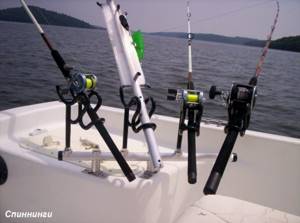
There are special sea spinning rods designed for fishing in salt water. They resist its aggressive effects well thanks to the use of special materials and coatings. They also use ordinary gear designed for fishing in freshwater bodies, but after each fishing it is advisable to thoroughly rinse them to remove any remaining salt.
Coil
For sea fishing, any spinning reel that balances with the rod is suitable. The choice should be made in favor of specialized models designed for use in salt water. It is made of materials that are resistant to aggressive environments, therefore it is more durable and will not fail after one season.
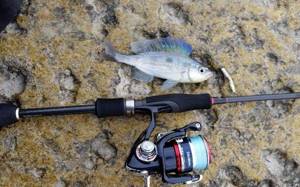
Balanced tackle is half the success in any fishing
Good reels are made by the companies Daiwa and Shimano, but their prices are impressive and not always affordable for every angler. Any inertia-free machine is suitable as a budget option, but you shouldn’t expect much from it. Most likely, it will start to act up after a dozen full-fledged fishing trips in salt water.
Some anglers like baitcasting reels. Now some Japanese brands specially produce models for light fishing rods. The advantage of multis is their increased strength life, power, reliability and wear resistance. However they are more expensive.
fishing line
For sea fishing, you can use both braided line and monofilament thread. The first is stronger, more sensitive, and abrasion-resistant. Nylon better withstands aggressive environments and is almost invisible in water. However, its extensibility is the main drawback that prevents proper microjig fishing.
Advice! It is better to have a reel with several spare spools on which both cord and monofilament are wound.
If preference is given to the cord, then its optimal thickness will be from #0.4 to #0.8 according to the Japanese classification. These are light and medium class cords with a breaking load of up to 4–7 kg. We pay special attention to the abrasion resistance of the thread, since in most cases you have to fish on a rocky bottom.
If we are talking about monofilament, then we choose a model with a diameter of about 0.20 mm with a tensile strength of up to 5 kg. Depending on the fishing conditions, its color is selected. When fishing among stones, we take a dark color, on sandy soil - yellow, among algae - green. The most universal is white or transparent fishing line.
It doesn’t matter which manufacturer the braided or monofilament line comes from. The product must be of high quality and meet the requirements of sea fishing. Among the famous brands are cords and nylons from:
- Varivas;
- YGK;
- Daiwa;
- Toray;
- Seaguar;
- Yamatoyo.
From the mid-price and budget segments, we can highlight threads from Sunline, Power Pro, Kosadaka, Salmo.
It is recommended to use fluorocarbon fishing line as a leash or when installing spaced rigs. This material, in addition to being inconspicuous, has increased abrasion resistance, which allows you to safely fish among stones, pebbles and shell rock.
Loading and hooks
For sea fishing, it is advisable to use elongated sinkers. The best option would be in the form of a “stick”. Various drops, balls, and lentils will often get stuck among stones, but elongated loads will be able to pass through difficult areas.
If you decide to fish with jig heads, then classic round ones are not recommended for the reason described above. Cone weights are chosen because they can slide between rocks and pebbles, minimizing the number of snags.
The weight of the shipment can range from 1.5 to 15 grams. The higher the weight of the load, the better the bait will be felt and the predator will bite, but such equipment often gets stuck in the stones. Therefore, the most popular are “sticks” and jig heads weighing from 2.5 to 7 grams.
In this fishing, you should use either single or small offset hooks. Choose models specially designed for fishing in salt water. Marine series tees are also installed on wobblers. They are thicker, stronger, and are not afraid of prolonged exposure to aggressive environments.
Marine ultralight with Pavel Nagirny.
The sea provides unlimited opportunities for any angler's preferences. Whether it's feeder-donka, float fishing or spinning. Catching fish, squid, octopus, cuttlefish. Each of the directions is diverse, we will try to talk about them all on the pages of adriaticnature .
There are much more small fish in the sea than specimens weighing several tens of kilograms. But this doesn’t make it all that easy to catch them. Light spinning tackle at sea is a source of joy from getting to know various types of fish, fighting very strong sea rivals, regardless of their size, and simply endless pleasure from communicating with the sea.
Few people can talk about fishing with a light spinning rod in the Adriatic Sea with more knowledge than the fisherman who today lives in the Czech Republic, but has an almost thorough understanding of the preferences of Adriatic fish, Pavel Nagirny .

(Pavel Nagirny. Photo © Pavel Nagirny)
Leaving questions to Pavel about fishing with “heavy artillery” for the future, adriaticnature tried to figure out fishing in the “ultralight” and “light” style.
Pavel, hello! Thank you for taking the time to chat. There are a lot of questions). Let's start with the first and quite important one. A fisherman who finds himself on the shores of the Adriatic often cannot have several “light” spinning rods with him for various reasons. One is “ultra-ultralight”, the other is simply “ultra”, the third is no longer ultra. Is there a “universal” tool that allows you to fish with silicone baits on light jig heads, cast jigs, and use a bombard? You travel often, how did you solve this issue for yourself?
From the very beginning, I did not pose the question of choosing a rod for “ultralight” fishing in the sea, since I, and, I think, like every spinning player, had in our arsenal so-called microjig (MJ) rods, which we use to fish in freshwater reservoirs of familiar fish such as perch, pike and pike perch. However, most of these spinning rods were originally designed and created by manufacturers specifically for sea fishing, for such “iconic” fishing styles as “mebaring” (Mebaru is a small sea fish (lat. Sebastes inermis) from the order of scorpionfishes, fishing which is very popular in Japan and other eastern countries) and “ajing” (ajing. Aji is a Japanese mackerel, fishing for which is also very popular in eastern countries).
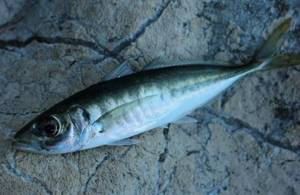
(Mediterranean horse mackerel. Photo © Pavel Nagirny)
On my first trip to the sea, I took a “mebark” with me. A rod with a not very thin tip, a butt rod, moderately elastic, but quite rigid. I’ll say right away that for me the most important thing in a spinning rod for sea fishing is the “viscosity” of the blank, since many fish take the bait very carefully and therefore are caught at the very edge of the mouth. In some species, the very structure of the mouth contributes to the descent: the soft jaws of horse mackerel, the small and toothy mouths of sea crucian carp, the long thin and hard “beaks” of garfish.
I think many will say, “guy, what is the purpose of the clutch on the reel?” I have spoken on this topic more than once with anglers, mainly with those who love “dry-hard” spinning rods. First of all, they have to rely on the friction brake of the reel, since the spinning rod almost does not dampen the jerks of small fish.
The drag of even the best reel is not a panacea. Many of the pelagic species of fish, and not only pelagic ones, the same sea crucian carp, after hooking are capable of developing such kinetic energy that your adjusted friction brake of the reel for a two-hundred-gram horse mackerel simply will not work, and at the other end of the tackle the jig hook will be bent or broken. head, or it will be torn off altogether.
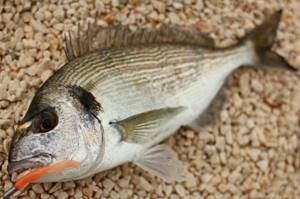
(Dorada, or golden spar. Photo © Pavel Nagirny)
Therefore, it is very important that the rod extinguishes fast “spurts” as best as possible - as sharp and aggressive jerks of fish are often called. And when playing, it was loaded as evenly as possible throughout the entire form, and not just in its upper part. If the rod is “dry”, hard, “extra fast”, then you can loosen the clutch and fish for horse mackerel weighing two hundred grams, but if the same half-kilogram pompano or Lichia of the same weight “sits” on your bait, This situation can be compared to climbing a steep mountain with a sports bike - you pedal, but it stands still.
In my understanding, it is spinning rods with a tubular tip (“tubular” - a regular hollow tip, which in most cases has less flexibility than a “solid” tip - with a monolithic insert made of more flexible fiberglass or low-modulus graphite) for catching mebaru, which are more universal for fishing in the Adriatic. They are longer, usually 7'6”-9'1”, which is especially good for long casting, as I have never caught a pelagic predator at close range. Softer and more elastic, often having a fast action (fast) or less fast regular fast. But, not extra fast!
They also have a wider test - a range of weights of baits thrown, which allows you to significantly expand their range in your boxes. With this rod you can fish with silicone baits with jig heads, small “creatures” - fancy silicone baits that imitate marine and other creatures, and silicone “worms” using spaced rigs (Texas rig, Carolina rig, Drop shot rig, etc.). d.). And also for small stickbaits, rigs with bombards for long casting, for example, Tict M-Caro, jigs, oscillating spoons, etc. With a longer and butt rod it is more convenient to cast fish onto the parapet of the embankment, onto piers, or onto stones when fishing from the rocks.
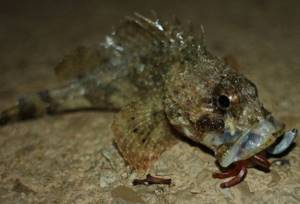
(Sea ruff, or Black Sea scorpionfish. Photo © Pavel Nagirny)
Of course, this all applies to those cases when you do not have the opportunity to take more spinning rods with you. If there is such an opportunity, then two spinning rods will be more than enough for you. One for short-range fishing, with a weight of 0-6 grams, and the second, for fishing at long distances and with heavier lures, with a top weight of up to 12-15 grams.
For myself, I have never considered a travel rod and never will, but I’m not saying that there is no place for it. Personally, I’m just not comfortable fishing with a spinning rod that has more than two legs. I’ll go a little away from the topic - I often went fishing in public transport with a casting single-piece spinning rod, 213 cm long. Yes, it’s not very convenient in transport, but what an impression it was during the fishing itself! Therefore, you must decide for yourself what is your priority - fishing or the vacation itself, and build on that. In any case, the surcharge for a tube from airlines is approximately 50-80 euros, and this is not such a lot of money that you would be deprived of the pleasure of fishing.
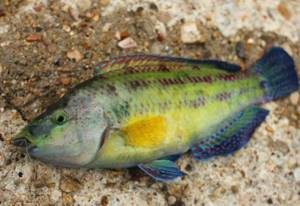
(Greenfinch, or roll. Photo © Pavel Nagirny)
With spinning rods it has become more or less clear, but which reels to use at sea? Very often you come across the fear of fishermen to take their “pets” with them on the same vacation, including because of the fear of making them unusable. What do you think about this?
As for reel manufacturers, here, too, everyone needs to decide for themselves which brand they like best. Each of us has different financial wealth, and this factor directly influences the decision when buying an expensive “top” model or a mid-price reel. If a person is willing to invest time and a little money in professional maintenance of his reels, then you can buy a good used one, and gradually, or immediately, a specialist will put everything in order for you.
People's fear of using their favorite reels for sea fishing is justified, since salt water harms any metal products. Even if your reel is of the “top” level and marked SW (salt water), this does not mean that nothing will happen to it if it is used carelessly in salt water. Reels with this designation have a better paint finish, protected (closed) bearings, and various systems to prevent water from entering the mechanism, for example, the Shimano brand is based on different bushings and gaskets (Coreprotect, X-Protect). Such systems protect the line roller and the main mechanism of the reel from direct ingress of water, but with all this it is impossible to avoid the troubles that salt can cause without doing anything to the reel.
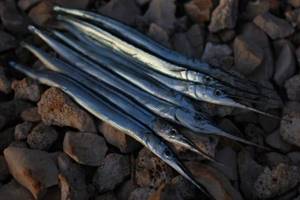
(European garfish. Photo © Pavel Nagirny)
We need to start with preventing problems, that is, with prevention. At a minimum, try not to put the reel in sea water or put it in sand. It is more than advisable to rinse the reel with running fresh water after fishing. And in any case, the coil must undergo “technical inspection” and carry out “maintenance”. Sooner or later, salt will get into the reel mechanism, which begins to corrode the metals and body coating. In some cases, “maintenance” must be carried out immediately - for example, if sand accidentally got into the reel. It immediately begins to damage parts of the mechanism if you continue fishing without doing maintenance and removing sand from the reel mechanism.
Regarding reel size, I am one of those anglers who believe that there is no point in going below Shimano size 2500. I only had the smaller reel for one season, and after I parted with it, I was very happy about it. With small reel sizes you only gain in weight, nothing else. At sea, you need a universal reel with a sufficiently capacious spool and the ability to cast far, so size 2500 according to the Shimano classification is quite suitable for you, and besides, you can animate any bait paired with a spinning rod up to 12-15 grams without harming the mechanism.
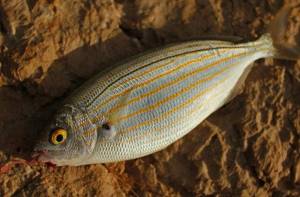
(Salpa, or sarpa. Photo © Pavel Nagirny)
The next and necessary part, in my opinion, is a smooth friction brake on your reel. I use reels with a bobbin assembly system; the same Shimano brand has this system called Rigit Support Drag. In some reel models, this unit has a bushing that can be replaced with a bearing of the same size. With this system, the reel spool does not “float” when the clutch is greatly weakened. When you fish using thin lines, their release when the enemy jerks occurs more smoothly, which is very important if you have a bite from a large fish.
In general, you can fish with any reel, but the main thing is to use it with care. After each sea fishing, it is advisable to rinse it under running fresh water with the friction brake applied and let it dry. And upon arrival, carry out maintenance from a specialist or yourself, if you understand the issue. If you live by the sea and fish often, then it is better to undergo this maintenance once or twice a year so that you can enjoy your favorite reel for many years.
You often hear the arguments of fishermen who say “yes, for that kind of money it should ...” It doesn’t owe anyone anything. Everything breaks, is destroyed and damaged. There is no eternal technology. If your expensive car or TV breaks down, why can't a relatively inexpensive reel break? And when you change the oil, filter, seasonal tires of your car, why don’t you do exactly the same service, only for the coil, from a specialist, or supply and replace spare consumable parts?
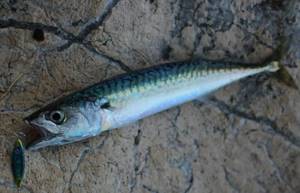
(Atlantic mackerel. Photo © Pavel Nagirny)
Which braided lines or fishing lines do you think are best suited for sea fishing? What kind of fluorocarbon are you using?
Cords. No, of course, you can fish with fluorocarbon lines or polyester, by the way, this is very popular in Japan, but most often anglers tend to use PE cords. There are plenty of excellent products from Japanese brands on the modern fishing market, and I won’t recommend just one. As for my experience, after using cords from the Japanese brand Sunline, I switched to products from the Japanese brand Varivas. Although I will remember the legendary, in my understanding, Sunline Rock Fish PE for a long time, it is, perhaps, one of the best “threads” I have ever fished with.
For the “lightest” fishing, I use four-core cords according to the Japanese numbering #0.4. Previously, I used #0.3, but one size thicker line gives you a better chance at biting large fish, and you are also less likely to shoot bait close to the upper test range of the rod. Recently, thin eight-core cords have begun to appear more and more on the fishing market, but their cost is much higher than four-core ones.
I use fluorocarbon “leaders” from different manufacturers. For bottom fishing - Sunline FC Tornado V Hard HG, thickness #1.25-0.185 mm and #1.5-0.205 mm, as well as Duel HDCarbon thickness #1.5-0.205 mm. For fishing in the upper layers of water and using M-caro bombards, I use Varivas FC Light Game with a thickness of #1.2-0.185 mm.
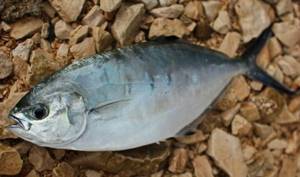
(Pompano, or European trachynot. Photo © Pavel Nagirny)
Tell me, please, what should be the set of baits for a spinning angler who is planning to devote his vacation at sea to UL fishing? Or an angler who doesn’t know what baits he should start with, because their range is huge.
Yes, there is a huge selection of baits, I would even say that the fishing market is oversaturated with them. But, as practice shows, a small number of brands still have their own secrets and developments that greatly distinguish their products from mass products.
Most often I fish with silicone and metal baits, since they are the best to search for fish and set the fishing horizon. But I also use “plastic”. By the word “plastic” I mean “minnow” wobblers, surface baits – poppers and walkers, and my favorite sinking bladeless wobblers – “sticks”, or “stickbaits”.
If we compare the catchability of baits in the marine “ultralight”, then I would still put silicone in first place, then metal “jigs”-jigs, and finally “plastic”.
Almost any fish on the Adriatic coast actively responds to silicone baits. By taking bait of three main forms (“slugs”, “worms” and “crustaceans”) with you when fishing, you can catch a large number of different representatives of the ichthyofauna. Sea crucian carp, rock perch, garfish, horse mackerel, scorpionfish, gobies and many other species will not remain indifferent to them.
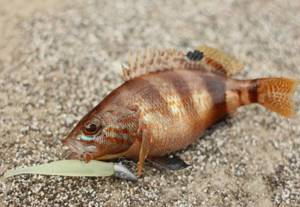
(Mediterranean rock bass. Photo © Pavel Nagirny)
Many marine silicone baits often differ little from their counterparts for freshwater fishing, but they have different colors and, most importantly, resistance to fish teeth.
Light marine spinning rods often use pink, white, red, transparent and Glow colors. At the same time, these colors are not the most popular for freshwater fishing.
If in fresh water the “survivability” of a silicone bait is not so important, and in many situations the softest and not the most durable baits save fishing, then in sea fishing this is a very important factor. If you fish with soft, fragile baits, then you will lack one of two things: either bait or nerves. Saltwater fish are very fast, aggressive and toothy, so often one bait is not enough to complete the retrieve. And you have to change one bait after another.
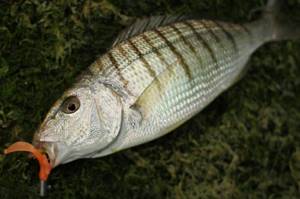
(Atlantic mormora, or Atlantic shrew. Photo © Pavel Nagirny)
Of all the silicone baits that I tried to fish with, I give my preference to the products of the Japanese brand “Maria”. Their baits are made of a special material that has those very important qualities for me, namely softness and increased resistance to aggressive bites of toothy fish.
In second place in terms of catchability, I would put the baits of the cult Japanese brand “Tict”. The baits of this company have shown themselves well when catching different types of fish, although they are not as durable as the baits from the above-mentioned manufacturer “Maria”, so some fish manage to bite off and gnaw pieces out of their bodies.
Finally, it is worth mentioning the third in my personal rating for catchability brand “Jackall”, namely the bait called “Peke Peke Long”. This bait performed well when catching garfish. When catching this fish, I use this bait on a jig head weighing 1.5-2 grams, and lead with a fast monotonous retrieve with short jerks. The most popular colors for me are pink, orange-carrot and white shades of Glow, then pink-transparent UV and transparent with silver “glitter” - sparkles. The most commonly used bait size is 1.8''-2.8'' (45-70 mm).

(Zebra rockfish, or cuckoo. Photo © Pavel Nagirny)
A very popular bait among sea fishing enthusiasts is the Marukyu Power Isome, which cannot be ignored. Personally, I don’t like it, as it attracts all living things nearby, and it becomes difficult to catch interesting fish due to the constant bites of small things. However, if your goal is to catch someone at any cost, then this is exactly what you need. I fished with the Marukyu Power Isome in a strong wind, when nothing else was biting, and when bites did happen, they were almost unnoticeable. My then four-year-old son caught his first fish with this bait. My wife and sister also fished well with these worms, although they had never held a spinning rod in their hands before.
In general, there are countless offers on the market, and in the heat of the moment you can fill a suitcase of silicone baits, but believe me, it’s not worth it.
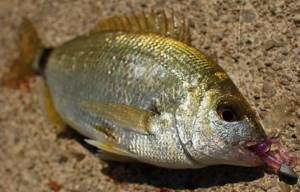
(Laskir, or sea crucian carp. Photo © Pavel Nagirny)
In addition to the three brands that I mentioned, I, of course, fish with many other baits from different manufacturers; on every trip I try to take something new in order to understand and find a bait with the best catching qualities. But so far it is Maria, Tict and Jackall that have taken leading positions both among the fish and in my bag with silicone baits.
The second type of bait is metal jigs or jigs, which are also presented in a wide variety on the fishing market. Both by manufacturer, and by shape, and by weight, and by color scheme.
Jigs can be divided into three main types: these are “jigs” with a center of gravity in the tail or closer to the middle for fairly fast retrieves; “slow jig” – wide baits that crumble slowly in an almost horizontal position, thanks to the center of gravity located almost in the middle; and thin, so-called “slim Jig”, although now some manufacturers are already writing “super slim Jig” prefixes for their products. It is also worth mentioning about “TG Jig” (TG-Tungsten) - these are compact and heavy tungsten jigs, which are very convenient for breaking through headwinds, they quickly reach the bottom at great depths due to less resistance and their weight, and also do not blow away so much with the current.
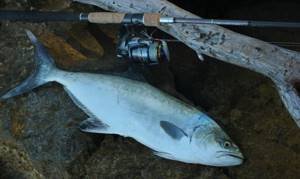
(Common Lichia. Photo © Pavel Nagirny)
It’s difficult to say that any one type or form is the most catchy; probably, it all depends on what the fish believes in, what seems most similar to the object of the hunt at the moment.
As for the weight and color of the jigs. Today, these baits are made in weights from one gram to relative infinity and in all sorts of colors. The most popular and catchy metal jigs in my box are jigs weighing 5-7 grams for fishing in the coastal zone, and 9-15 grams for long casts when searching for predators at depths of up to 20 meters. The most “working” colors are “sardine” and silver.
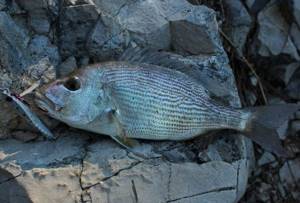
(Common dentex. Photo © Pavel Nagirny)
In the end, I want to say a few words about plastic baits. Why at the end? Because, perhaps, in “easy” fishing, not everything goes so well with them, at least for me. With small minnows I was able to catch only a few medium-sized sea bass and rock perches; small topwaters brought several half-kilogram dashing fish.
But with small “sticks” - “stickbaits” we caught sea bass, rock perch, medium-sized wolffish, garfish, black-tailed fish and redfish. On my last fishing trip to Croatia alone, I caught more than a dozen half-kilogram lizards on a Tict x Lucky Craft Wander 50 Lite. In general, this aesthetic type of bait still needs to be understood in more detail in “light” fishing, since in “heavy” fishing, plastic occupies one of the leading positions, regularly bringing in large sea predators.
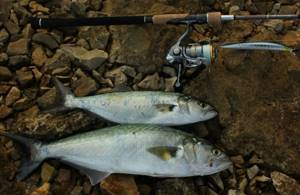
(Lufari. Photo © Pavel Nagirny)
For the silicone baits you talked about, there are a considerable number of weight options. There are countless different types of jig heads. There are also split-shot, drop-shot, Carolina, special marine developments - buller, barakuri and others. Do different jig head shapes make sense? If so, which ones performed better than others? Is it worth experimenting with other loads? How did the bullers and barakuri perform in the Adriatic?
That's right. The variety of jig heads and different weight options is many times greater than the number used in freshwater fishing.
Is it worth experimenting? Certainly! It is more convenient to work with jig heads alone when moving along the bottom, equipped with baits in the form of various crustaceans, the so-called “creature”. Other jig heads are more convenient for fishing in the bottom, middle, and subsurface layers, the so-called “pelagic jig.” The lightest heads weighing only 0.2-0.6 grams are good for purposefully catching horse mackerel and other fish in the upper layers of water using a bombard.
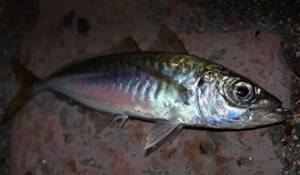
(Mediterranean horse mackerel. Photo © Pavel Nagirny)
Until today, I have had the opportunity to fish on many models of jig heads from such Japanese manufacturers as Decoy, Magbite, Cultiva, Shimano, Tict, Breaden, Xesta, Morigen, Junglegym and, on my last trip, discovered the Thyrty 34 Four brand.
For night bottom fishing with “creature” lures, I liked the Junglegym Sleeper Jig Head weighing 2-4 grams the most. On this head, the bait sits on the bottom at about a 45-degree angle, resembling the natural position of a crustacean. When retrieving, the bait never falls on its side, and after each jerk-jump pause, the bait sways, reminiscent of a living organism. I want to say that for feeding “crustacean” silicone baits, the shape of the Sleeper Jig Head is simply ideal, and at the moment it’s difficult for me to imagine anything better for this method of fishing.
For bottom fishing and fishing in the bottom layers during daylight hours, with a more aggressive and fast retrieve, I most often use Magbite Upper Cut Jig Head weighing 1.2-2 grams, Shimano Soare Skiphead 1.3-1.6 grams, and Decoy Rocket Plus 1.8-2.5 grams. On the first two, Magbite and Shimano, I use larger lures such as Maria Dart Squid 2”, Maria Action Fish 1.8”, Tict Briliant 2.5” and the like. Decoy Rocket Plus I have a more “crucian carp”, I would say so, and I use them with such baits as Maria Aji flutter 2.3”, Maria Slim crawler 1.8-2.3” and the “volumetric” model Maria Clione 1.2-1.8”. It was on this jighead that Clione was most productive.

(Brown grouper. Photo © Pavel Nagirny)
In no case do I encourage you to fish only with the above-mentioned silicone baits, I just want to say about the shape of the jig heads and the shape of the lures, which together showed the best results.
The last and newest in my box were the Japanese brand Thyrty 34 Four Driver Head jig heads. They came to me by chance before a trip to Croatia - I was talking goodbye to a friend near his car, the friend took out a package of Driver Head from the depths of the trunk and showed it to me, I asked him for one to try, since I had never caught them before. A friend handed me a whole package with the words that he didn’t need them, I couldn’t refuse.
Already in Croatia I caught horse mackerel using a bombard. Frequent gatherings forced us to install more and more light jig heads, but little changed. The offensive gatherings continued until hands reached Thyrty 34 Four Driver Head. And, miraculously, they ended. Imagine, more than ten morning fishing trips - and not a single fish caught. The hook of this jig head pierced the horse mackerel's mouth in its toughest parts, then leaving it no chance to escape.
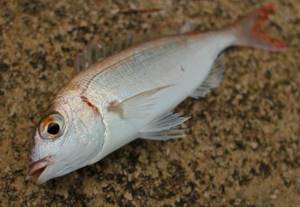
(Atlantic, or red pagel. Photo © Pavel Nagirny)
Texas rig and Carolina rig. The load is the same - lead or tungsten bullet, but the designs are different. If, when equipped with a Texas rig, the bait follows almost closely behind the load, then in the case of the Carolina rig, the bait moves at a distance of the length of the leash from the load, and, in the presence of a current, hovers above the bottom without touching it.
Most often I use Texas rig, very rarely - Carolina rig. Fishing with these rigs mainly occurs at long distances, since it is more convenient to fish with jig heads at short distances. When fishing with Carolina, you get a lot of idle bites, since the bait is attached to a leash, it dangles almost in “weightlessness,” and fish attack it from different sides. The bite on Texas is more clear and informative, the fish catches up with the bait, the blow is transmitted to the hand, and you manage to hook the predator.
With a Texas rig, I usually use small “creature” baits when fishing for rock bass. For all other types of fish, Marukyu Power Isome worms are perfect; it was on the Power Isome with such equipment that I managed to catch several specimens of the Mediterranean bothus (Bothus podas), which I so much desired. Grouper is often caught using this method, but I have not yet had the opportunity to purposefully catch this fish with the help of Texas, since groupers did not live in large numbers in the places where I fished in the Adriatic.
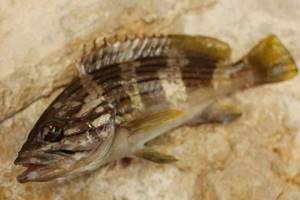
(Alexandrian merrow, or golden-spotted grouper. Photo © Pavel Nagirny)
Drop shot rig is another rig I rarely use when fishing in the sea. In my understanding, it is necessary when you need to “trample” the bait on a rocky bottom area near boulders, or over grass.
I would like to give one case as an example. My friend and I caught river perch using a drop shot rig in the Czech Republic on the Elbe River. He was very surprised at the fishing pace that I used - “treading water,” as I call it, with the bait in one place, without lifting the load from the bottom. And then, slightly moving the bait, continuing the same algorithm of actions. Quite boring, but “for passive fish” this method of fishing worked and works more than perfectly. He was surprised, he was familiar with such fishing, but this was the first time he had encountered such a slow pace of fishing.
That same fall, Taras, that was his friend’s name, went to Croatia, where he had the opportunity to fish in a large shallow sea bay. The depth in those places was no more than a meter, the bottom was covered with dense aquatic vegetation, and it occupied half the space to the surface. Remembering the drop shot rig and the same Keitech Sexy Impact 2.8” bait in the Hot Fire Tiger color, with which I successfully caught perch that day on the Elbe, he built the same one, and did not catch, but caught sea bass weighing up to a kilogram. The fish stood in the grass and attacked the bait, jumping out of its thickness. And although the color of the bait was not “marine” at all, nevertheless, in this situation, with this presentation, it was this method - drop shot rig - that proved itself above all praise.

(European sea bass. Photo © Pavel Nagirny)
Bombards. A separate topic for a separate article. I don’t have enough experience for this yet. There is a large selection of bombards on the fishing market, but so far I have only fished with the Tict M-Caro. Some people neglect this method of fishing, uttering a phrase that is not very clear to me: “a bombard is not a “clean” spinning rod.” In my understanding, a bombard is just another type of weight with which you can throw a light bait relatively far. With the help of a bombard, it is also convenient to fish different layers of water in search of active fish. After all, bombards are produced not only floating, with neutral buoyancy, but also sinking. So far, the best result has been shown by the following combination: Tict M-Caro N weighing 8 grams + Thyrty 34 Four Driver Head weighing 1 gram + Maria Aji flutter 2.3-2.8” in S\RG Glow color.
Bullers. An interesting option for sea loads that can easily pass obstacles on the bottom. But not a panacea. Bulers also come off on hooks, like jig heads, but they are more expensive. I didn’t notice any super advantages when using them in fishing, so I don’t have much interest in them, but they are always present in my box.
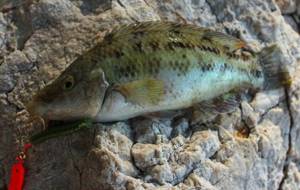
(Greenfinch, or roll. Photo © Pavel Nagirny)
Barakuri. I don't understand Barakuri at all. It seems to me that they need a vertical component, for example, fishing from a kayak is their path. All my attempts to fish from the shore with a load of bait using barakuri ended with vague, fruitless bites, and often the fish simply pulled the bait off the hook.
Split shot rig. I admit, I haven’t fished with it in the sea, because, probably, I haven’t found that place yet, or rather, it just hasn’t occurred to me yet where such equipment would be more preferable than others. However, I always take weights for fishing with split shot with me on sea fishing, feeling that someday I will find a use for them.
I would like to say a few words about the methods of placing baits. I would like to note that I am not a fan of fast speeds; more precisely, I don’t like to rush when the situation does not require it. The joy of the fishing process itself is the main thing for me. It’s somewhat surprising to me to see how many anglers make some crazy high-speed moves when fishing with sea “ultralight”, using classic “jigging” moves, which are often used when fishing for perch or pike perch.
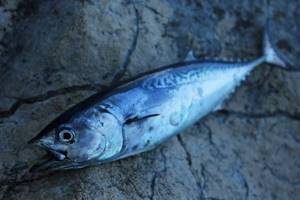
(Spotted or small Atlantic tuna. Photo © Pavel Nagirny)
It may seem strange to some, but in my not very extensive experience, all these fast retrieves work much worse than the banal uniform wiring of plastic baits or jigs. The sea is inhabited not only by fast pelagic fish, for which movement is an integral part of their life, but also by various bottom predators that leisurely follow the bait, and only after believing in its realism do they attack.
In my opinion, the most distrustful sea predators are seabreams and seabreams, and along with their size, their caution also increases. Very often I had the opportunity to observe when some sea crucian carp followed a silicone bait “walking” along the bottom, carefully studying it, without attacking it. And only by adjusting the pace of the retrieve was it possible to persuade the crucian carp to bite.
When I understand that there is a fish at the selected “point”, but is not “eating”, I slow down the movement of the silicone bait and try to work more on the animation. Very often, when the fish shows at least minimal interest in the bait, the following maneuver brings good results: I stop the bait in place and start playing with the tip of the rod, giving them a series of short but quite sharp jerks, forcing the “worm” on the jig head to move, practically without moving from its place. And only then, after a confident bite, when the fish has bent the tip of the rod, I hook.
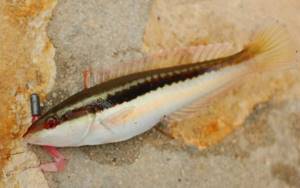
(Sea cadet. Photo © Pavel Nagirny)
This is what I wanted to say about the distrustful fish. But there are also shy fish. For me, they are the inhabitants of the crevices of the walls of piers and embankments. These are mainly large gobies, scorpionfish, small groupers, rock perches - cuckoos. If you set out to catch these cautious predators, the distance of the bait from the place of their “ambush” is very important. These fish need assurance that after they grab their prey, they will immediately hide in their bunker before another, larger predator eats them. You need to place the bait almost close to the walls of piers and piers, only then will you provoke the “timid” ones to attack.
The “timid” manage to dictate their own rules. Instead of your confident hook as such, it requires your readiness for a quick hook, you won’t miss it, it’s aggressive. And your quick reaction is required - you must not give the enemy a second of slack, otherwise he will go into the crevices, and you will be left with your nose, or rather without bait, immediately engage in battle. With the clutch tightened. If you want to know your reaction speed, I advise you to try this type of fishing, the bulls will explain to you how fast you are.
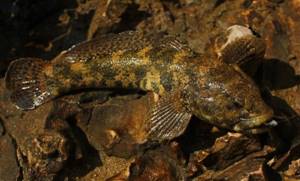
(Grass goby. Photo © Pavel Nagirny)
And one more thing - the “timid” are afraid even of the shadow. Your shadow will interfere with you. Move deeper into the pier if the sun is behind you. And check your reaction.
A few words about fish that are popular among fishermen. Horse mackerel and garfish.

(Mediterranean horse mackerel. Photo © Pavel Nagirny)
Horse mackerel. Bombarda is a great helper. The fishing technique using a bombard is quite simple. Casting, a short jerk, in order to eliminate possible overlap of the bait with the leash or cord. Next – uniform and fairly fast wiring with “stretches” and pauses. If the fish does not react to the bait near the surface, I begin to look for the horizon where the fish can stand, and lower the bait a little deeper, using a sinking bombard, counting to myself (one-two-three-and so on) in the hope that I will understand at what “calculated” depth the predator is active. Conditional “ten”? I will fish at this depth, fishing in this particular layer of water.
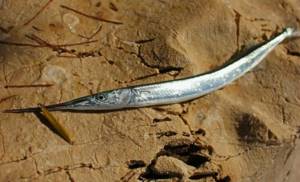
(European garfish. Photo © Pavel Nagirny)
Garfish. I found two “working” approaches to it. First: silicone bait that does not have its own active game. Jig head, fast retrieve with short and fairly “strong” jerks. With this technique, the bait “scours” the water column without deviating too much to the sides. Second: small stickbaits. If the stickbait is thin, like, for example, the same Tict x Lucky Craft Wander 50 Lite, then, in my opinion, fast retrieving with frequent short jerks will not leave a single Adriatic garfish indifferent to the bait. But, if the stickbait is quite voluminous, like the Duo Tetra Works Yurameki, then it is better not to rush and not jerk; a medium-fast, uniform retrieve will be in favor.
I would like to continue the conversation, but it seems to me that there is too much information for one article. Let's take a break and continue discussing the topic of “ultralight” on the pages of adriaticnature in a more specific and highly specialized manner. And not only on this topic.
Let's draw the line. A few more words. Accessories for fishing. In my humble opinion, every fisherman should have a special fish grip with him. I use Dress Dino Grip for peace of mind. There are alternatives on the market, your choice is, of course, up to you.
A fishing towel is a very necessary thing! Made of dense material, with the help of a rivet it can be fastened to a loop on your pants, bag, or backpack. Dry your hands before handling a camera or a sandwich. I have been using the Sunline Towel TO-100 for several years now and am very pleased.
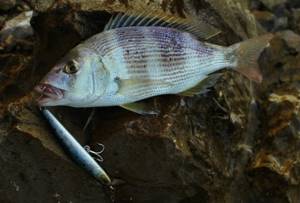
(Common dentex. Photo © Pavel Nagirny)
Don’t forget and don’t skimp on accessories. If you want to catch a barracuda, you will have to make your way along the rocky shores at dusk. Tie a fluorocarbon leash there. You need a quality headlamp!
Convenient boxes, scissors, tweezers, lip grips, knotters - I will not further list what makes your fishing comfortable and memorable for a lifetime. For me, in any case, the lack of useful tools does not make fishing better, but only spoils it.
Experiment, friends! Sea fishing is not about two or three turns of a reel with a sinker - a “Cheburashka” at the other end of the tackle. Not theoretical chatter in Facebook groups. Not Aliexpres - if you have the opportunity to run from him, run. Read the right things. Draw the right conclusions. Buy the right gear. Fish it right!
The sea is older than us. But it will make any teenager with a spinning rod or fishing rod in his hands fall in love with him.
I hope I was able to suggest something to you, if not, don’t be angry. But no matter how you react to the article, we will still sort out the details in the near future. With bombards too. And, of course, no tail, no scales!
Lures
When fishing at sea with a light spinning rod, it is better to use wobblers and silicone. These are the two most catchy categories of baits, which are distinguished by their versatility, imply different fishing methods, and allow you to perform various animation techniques, catching fish from the bottom and in the water column.
Standing apart are jigs, which are more often used when fishing vertically at depths. However, they are applicable from shore. For these purposes, you need to choose small models weighing from 3 grams. The most popular and catchy spoons are the well-known Kastmaster and Hopkins.
When choosing a specific bait model, you need to consider many factors:
- type and size of potential prey;
- bottom structure;
- depths at the fishing site;
- presence of current;
- illumination;
- water clarity;
- predator mood.
Any little thing can play a decisive role, from the size and buoyancy of the bait to its color.
Wobblers for fishing from the shore
A wobbler, contrary to popular belief, is an excellent bait for spinning fishing in the sea. They work all season. They can be used in different horizons for hunting any representative of the ichthyofauna. They are distinguished by the variety and variability of models.
All wobblers for sea fishing can be divided into two groups:
- Freshwater models that differ in hooks and colors. Available from many manufacturers.
- Specialized marine baits that have no analogues for fishing in fresh water bodies.
Among the former there may be crankbait, shad, and minnow. The second, sea wobblers, have an elongated body shape, like minnows. Inside such baits there is always a weight system that acts as an increase in casting range, stabilization of the game and an additional noise chamber.
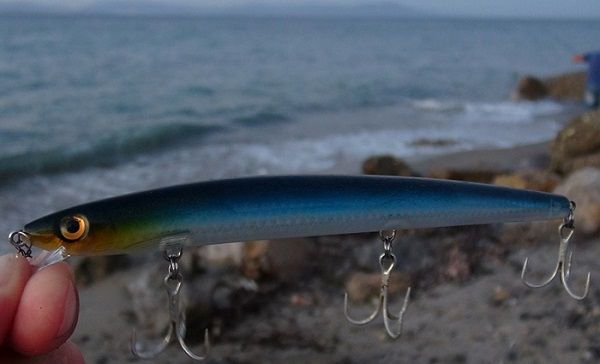
The classic sea wobbler has an oblong body
Many manufacturers produce wobblers for sea fishing from the shore, but the best are the lures of Japanese companies. Among them are products from Yo-Zuri, DUO, Bassday, Deps, Imakatsu, Jackall, Jackson and others. Other brands include:
- Rapala;
- Haddon;
- Halco;
- Halcyon System;
- Nils Master;
- Koppers.
It is better to start mastering sea fishing with wobblers from the shore with floating modifications. They are as simple as possible and forgive errors in wiring. We are gradually switching to sinking baits and suspenders. They are more relevant in the near-bottom horizon and as a passive predator.
Fishing from the shore and from a boat
In general, it is better to fish at sea from the pier, because in shallow water there is almost always a wave. If you fish directly from the shore, then you need to make a long cast in order to overcome this wave.
Fishing from the shore is good after a storm. Fishing spots will be on the border between muddy and clear water. But it’s better to fish from piers or breakwaters; clear water comes closer to them and the border is visible. The bait is thrown as far as possible into a clear area of the sea and taken to the border. In muddy water, you shouldn’t play with bait, don’t waste time, because there are no fish there anyway. Any kind of wiring, stepped, wavy, the main thing is that the bait is in the water column at the bottom, or drags along the bottom.
Catching fish that live on rocky bottoms is called “rock fishing.” These are mainly small fish species. The location for rock phishing is selected visually. Large coastal stones form small caves and shelters in which fish hide. You can view the bottom from a hill, if there is one. The presence of algae also indicates where fish live.
Look at the spinning fishing in the Canary Islands in Lanzarote, rock fishing:
But fish are not only caught between the stones; they are also caught well on the sandy bottom. For example, in the Black Sea there is such a bottom in the Anapa area.
The fish bite especially well in the sea at night. At sea at night, very fast wiring is used. The fishing pace at night can be very high.
If you fish from a boat, you need to look for fish. The fish move in schools and it would be nice to find such a school.
